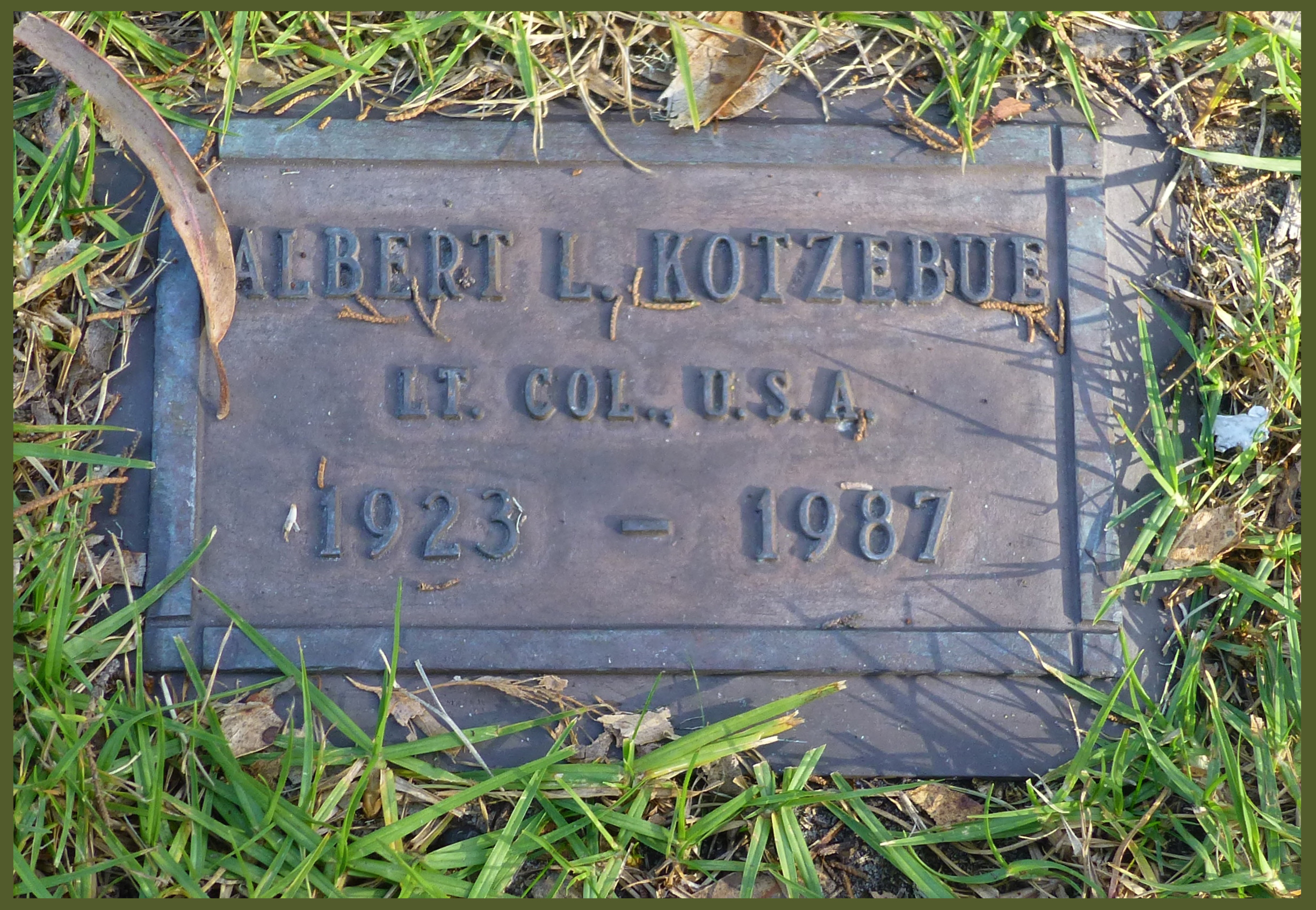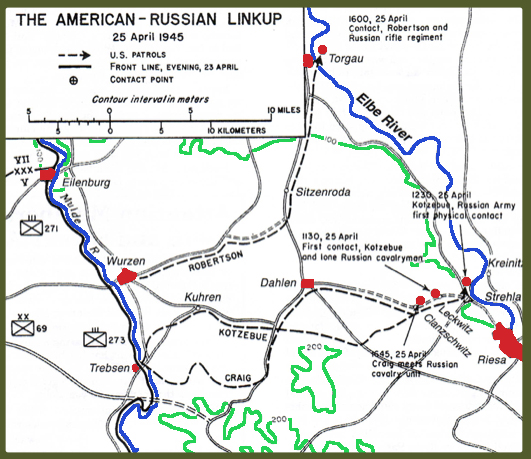
The Russian/Ukrainian – American Linkup 25 April 1945!
At San Francisco delegates to the United Nations Conference sat down to the business of their opening session to preserve world unity after the war.
At Leckwitz, Germany, an American Lieutenant and his patrol met a lone Russian horseman in a farmhouse courtyard at 1130.
At Torgau, Germany, another American Lieutenant reached out and gleefully pounded the knees of a Russian soldier as both hung precariously from a top girder of a destroyed bridge over the Elbe River at 1600.
At Clanzsochwitz (as written in the AAR), Germany (Kleinzschachwitz) a patrol led by an American Major spilled out of its jeeps and grinned happily at a troop of Russian cavalrymen at 1645.
The date was April 25th, 1945. The scenes were in the United States and on the Western Front of Europe. At 1300 the statesmen gathered to talk of the ways of peace, at the others the soldiers met to help end the fighting. The meetings in the three towns on and near the Elbe River were the first contacts in World War II between the American and Russian Armies, between the Western and Eastern Fronts. All were made in violation of orders, but the contacts effectively divided the Nazi Armies on the Continent and hastened the end of the war.
The historic linkup was made between units of famous Armies.

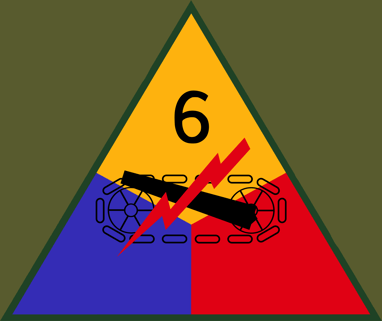
On the American side, the 273rd Infantry Regiment of the 69th Infantry Division, was involved.
On the Russian side, the 173rd and 175th Infantry Regiments of the 58th Guards Division, were involved.
The 69th Infantry Division was a part of V Corps, under Major General Clarence R. Huebner (see photo thereafter), and of the First U.S. Army under General Courtney L. Hodges, in the 12th Army Group of General of the Army Omar Bradley.
%2c%20Spaatz%2c%20Ike%20himself%2c%20Bradley%2c%20Hodges%20and%20Gerow.%20Standing%20are%20Stearley%2c%20Vandenberg%2c%20Smith%2c%20Weyland%20and%20Nugent_-1.jpg?width=373&name=This%20is%20the%20brass%20that%20did%20it.%20Seated%20are%20Simpson%2c%20Patton%20(as%20if%20you%20didnt%20know)%2c%20Spaatz%2c%20Ike%20himself%2c%20Bradley%2c%20Hodges%20and%20Gerow.%20Standing%20are%20Stearley%2c%20Vandenberg%2c%20Smith%2c%20Weyland%20and%20Nugent_-1.jpg)
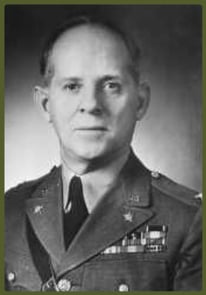
The 58th Guards Division was a part of the 34th Russian Corps, under Colonel General Gleb Vladimirovich Baklanov and of the First Ukrainian Army, under Colonel General Zhadov, in the Army Group of Marshal Koniev. The American Corps and Army concerned had made the first landings in the invasion of western Europe, while the Russian forces in the union had fought back from Stalingrad to the Elbe.
On that cold, misty morning of the 25th of April, two motorized combat patrols rode out from the American lines at Trebsen, on the Mulde River, and moved to the east. From Kuhren, a third patrol, dispatched late the day before, also moved east. Unknown to anyone, still a fourth, unauthorized patrol knifed out to round up PW's and returned with the glory!
The four were from the 273rd Infantry Regiment, 69th Infantry Division. All were operating under orders not to patrol beyond five miles east of the Mulde; three, despite these orders, went to the Elbe River and contacted the Russian Army, while the fourth one turned back.
The days before the first meetings between the two great military forces had been ones of rumors and reports and rising excitement. The German Armies were almost smashed and contact between east and west appeared imminent for days anywhere along the front. Unknown to the frontline soldiers of the other side, the Red Army had been ordered to halt along the line of the Elbe while the American Army had been ordered to halt along the line of the Mulde.
The two Armies in closest proximity were the American First Army and the Russian First Ukrainian Army.
Both had arrived along their respective river lines by about the 21st of April. The line troops on both sides waited for units from the other side to make contact.
In the growing anxiety of the American front, every odd ground formation became a "Russian tank" and every strange radio voice became "the Russians communicating with us".
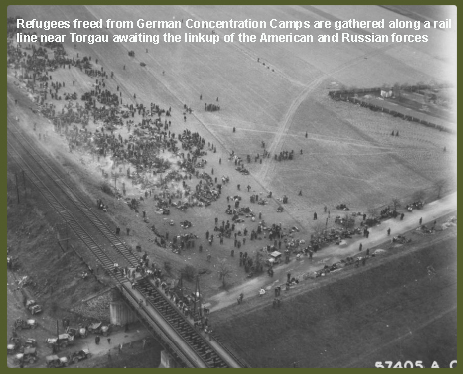
Elements of the Ninth American Army reported radio contact with the Russian forces early in the third week of April. A staff sergeant in the 6th Armored Division is alleged to have been in radio conversation with the Russians on the 23rd of April. The same day, the 1st Battalion, 273rd Infantry Regiment, reported a Russian tank to its front bearing a white horizontal stipe around its hull - the agreed upon recognition device. Investigation showed this to be an odd ground hummock with a clothesline stretched across it! Similar reports persisted up and down the front. Several units, such as the Cavalry Reconnaissance Troop of the 104th Infantry Division, had men out beyond their zones in hopes of being first to establish contact!
But, by the afternoon of the 24th of April, there still had been no meeting and, the American Army, at least, was chafing at the bit. That afternoon, Colonel C. M. Adams, Commanding Officer of the 273rd Infantry Regiment, sent out a patrol let by 1st Lieutenant Albert L. Kotzebue, of Houston Texas, 3rd Platoon leader of Company G. Kotzebue's orders were to "contact the Russians" but within the five-mile limit set by higher authority. He reconnoitered as far as the outskirts of Dahlen, found no Russians, and returned to Kuhren, where he spent the night because it was dark by the time he received orders to return.
That same night, at the Regimental CP in Trebsen, Colonel Adams briefed the leaders of two more patrols which he had decided to send out on the same mission the following day and gave them the same instructions, "contact the Russians", but, again, within the five-mile limit. Those were the orders, but there was a sort of humorous conspiracy among most of the patrol members that they were going to "meet the Russians", regardless! Nothing was heard from Kotzebue.
Before dawn on the 25th of April, the I & R Platoon, under 1st Lieutenant Edward A. Gumpert, and accompanied by Major James R. Sykes, Regimental S-3; Captain Faye L. Long, assistant S-3; and Captain Hans L. Trefousse, IPW officer attached from V Corps, crossed the rickety bridge over the Mulde at Trebsen first. Closely following was the patrol containing men from E & H Companies, led by 2nd Lieutenant Thomas P. Howard, of E Company, but with Major Frederick W. Craig, 2nd Battalion Executive as senior officer present, and accompanied by Captain George J. Morey, assistant regimental S-2, and Captain William J. Fox, First Army combat history officer. East of the river, the patrol divided, the I & R Platoon taking the northern sector, Craig's group taking the southern sector. Nothing was heard from Kotzebue.
The morning was cold and both patrols probed out their areas, capturing disconsolate German prisoners, uncovering hospitals, freeing Allied prisoners, receiving the surrender of enemy towns.
They sent back reports that the Russians were "at Terpitz", "at Gaunitz", "at Oschatz", "had a bridgehead at Strehla", "were very close". They reached the limits of their advance and asked permission to continue, each time with mounting urgency.
From Regiment each time Colonel Adams gave the order to "hold", although, with each passing hour, he could feel the growing impetuosity in each of the patrols.
Noon came and went. 1300.... 1400.... 1500.... The afternoon dragged on.
The I & R Platoon was being very conservative and remained within its area, being in the neighborhood of Frauwalde. Craig's patrol was east of Deutsch-Luppa. Both had been given instructions to return by dark, and the I & R already was on its way back. Nothing was heard from Kotzebue.
Then, into the Regimental CP by radio came the staggering message from Kotzebue!
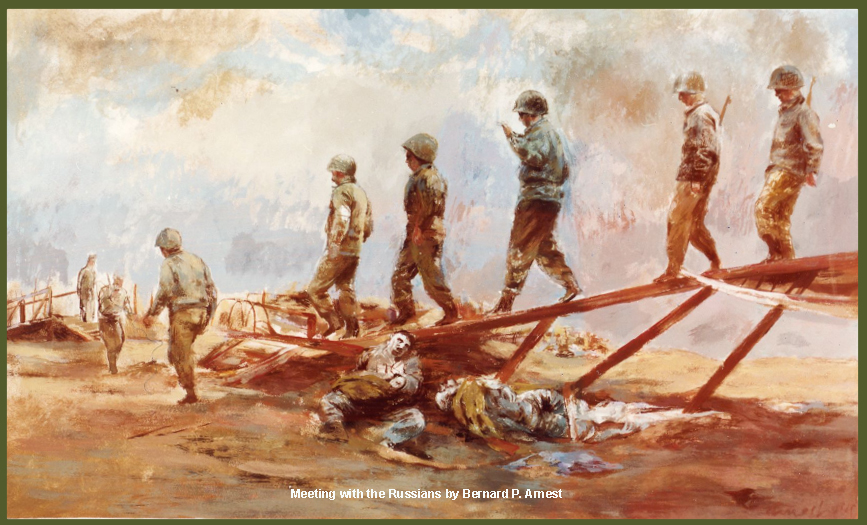
"Mission accomplished. Making arrangements for meeting between the CO's. Present location (xx.xx). No casualties".
It was timed at 1330; it was received at 1515. It had the additional note that the lieutenant had no direct radio contact with regiment, but had sent the message to the rear, where it was relayed.
That was it. The day before, V Corps had sent out a list of points of information and instructions which were to be gathered and complied with by any patrols making contact and a meeting between commanders was one of these.
There was nothing positive in the message, but Colonel Adams realized what had happened and noted its import immediately. He quickly called the Division CG, Major General Edwin F. Reinhardt, and the Chief of Staff, Colonel Charles P. Lynch, and passed on the news.
The General was as angry as a mad bull! Feeling outraged that his orders had been disobeyed. He told Adams to make every effort to check the report's authenticity, for he did not want to go out on a limb with another unfounded report. Reinhardt then called the Corps CG, Major General Clarence R. Huebner, who, in turn, notified the Army Commander, General Courtney L. Hodges! This upward notification undoubtedly went to the White house, the Kremlin, and Number 10 Downing Street. Very quickly the word went back down the line to hold off all announcements, not to make any firm agreements about meeting, and to thoroughly check the story of the reported contact.
Back at the regimental CP, photographers and correspondents began to flood in and add to the already-harried atmosphere there. The regimental commander was fairly positive in his own mind that contact had been made but the information at hand was not conclusive enough to give the whole picture. No one knew whether or not this single patrol had slipped through all the enemy forces by a fluke and then had the enemy close in behind it.
Within the hour, Kotzebue came through with another message which showed that negotiations were proceeding but not that the sector in between was clear nor with whom he was in contact: "Arrangements not complete. Will contact you later."
From where he stood, things looked very clear to Kotzebue. His patrol had ridden into Leckwitz and had met a lone uncommunicative Russian cavalryman in a farmhouse courtyard among a lot of displaced workers at 1130, asked him where his headquarters were, was on the west bank of the Elbe at 1205, and across by 1230, to firm up the first real physical union between the two Armies. The first contact was undramatic, but his meeting on the Elbe were very cordial. Having made the contact, he wanted to let regiment know what was going on, but did not want to say in radio message specifically that he had met the Russians.
Kotzebue had gone from Leckwitz to the Elbe at Strehla, which he mistook for Groba (Gröba, 01591 Riesa, Germany) on his map, where he crossed and engaged in some discussion with several Russian Officers before being returned to the west bank of the river and transported to another crossing site at a ferry farther north. He got off his message here, containing the wrong town coordinates, to Colonel Adams before he crossed to Kreinitz and met Major General Vladimir Rusakov, commanding general of the Russian 58th Guards Infantry Division.
While Kotzebue was across the river, being toasted and feted with his patrol, Colonel Adams was endeavoring to make at least partial and tentative arrangements for a meeting between himself and the Russian commander; "In arranging meeting for Tryhard 6 (Colonel Adams)" the Colonel radioed at 1604, "select a point not further east than GC 670-162". This was the town of Calbitz, a midway point which the CO thought would be acceptable to the Russians.
But the time continued to drag on and there was nothing concrete forthcoming from the reported point of contact. Everyone at regiment and higher headquarters was on edge with expectancy.
Finally, General Reinhardt, decided to try another method of obtaining concrete information. He told the Chief of Staff to have Colonel Adams hold off for the time being. As a result, Colonel Adams messaged the patrol at 1730: "Hold in abeyance of arrangements for meeting until further orders. Report by courier not repeat not by radio size and identity of Russian unit. Time and place of contact, type of communication Russian unit has with its next higher headquarters. Maintain contact and inform me of any movement".
In order to clarify the picture for himself and to have a senior officer on the scene, General Reinhardt, at General Huebner's suggestion, then dispatched his G-3, Lieutenant-Colonel Richard J. Conron, and an interpreter by liaison planes to the reported spot of meeting, at the set of coordinates given by Kotzebue. These later turned out to be wrong and the liaison planes reached Riesa, flew overhead, looked and could find no indication of a group meeting, allegedly were fired upon by small arms flak, and returned to Division headquarters. This added doubt and confusion to that already existing. Still time dragged on and no meeting of the commanders was made.
Then, in from Craig's patrol about 10 minutes after the "hold in abeyance" order came the report: "Have contacted Lieutenant Kotzebue who is in contact with the Russians".
This injected a new element into the situation! There were two reports of contact now, but neither of them said anything specifically. Regiment didn't now what sort of contact this latter patrol had made.
With Craig the story was different. His patrol had pushed on and on "just a little bit farther and maybe..." against orders with the full hell-raising conspiratorial agreement of all its members. At Clanzchwitz (?) they had been overtaken by a pair of jeeps from Kotzebue's patrol and told that he had made contact earlier in the day and at that time was on the east side of the Elbe, not far away.
Craig immediately gave the order to move forward and join. His line of jeeps had just about cleared the town when the patrol members saw a column of horsemen approaching from the east along a tree-lined parallel road on their right. The column stopped, the horsemen galloped up, and everyone's mouth dropped open. It was the Russians!
The time was 1645.
The meeting was short; the Russians continued on their mission to "Dresden"; the patrol raced to strehla, found nothing, turned north, crossed at Kreinitz, General Rusakov was on the east bank of the river and, after a long parley, during which it became clear to the General that this was another patrol, rather than the emissaries he had expected to see as a result of Kotzebue's radio messages, he took up the task of feting and toasting the new group! Both contacts thus far had come in the sector of his 175th Infantry Regiment, whose commander, Lieutenant-Colonel Alexander T. Gardiev, was one of the most decorated heroes of the Soviet Union and his best regimental commander.
There was nothing to do but sit back and wait and drink toast. A message which was sent from regiment at 1805 saying that two liaison planes were en route with the Division G-3 and an interpreter indicated that Division was going to do the negotiating. But, an hour later, when no one had arrived, Craig, who by this time had taken over supervision of all arrangements since the two patrols were now linked and he was senior officer at the Elbe, still wanted to know if Colonel Adams also was on his way to meet the Russian General. It was nearly 2000 when this query reached the CP, where the perplexity was more profound now that the Division planes had been turned back and Colonel Adams had been told by General Reinhardt to go ahead and try once more for a meeting himself. The CO still had no concrete word that arrangements were complete nor any idea that it was feasible to get through to the reported linkup point.
At 2004 he replied to Craig that he would leave as soon as arrangements were made and sat back, slumped in his accustomed chair in the corner of the room, holding his chin in his hand, the windowed terrace to his back.
The situation was still very much up in the air. He had two patrols in supposed union with Russians out beyond where they were supposed to have been, the Division commander was angry and, at the same time, anxious to firm up the reported contact, and yet there was nothing definite upon which he could act, although, in his own mind, he was morally certain that the long-awaited meeting of the Armies had taken place. The CP was still chaotic, although there was relative calm inside this S-2 / S-3 office, which had once been a drawing room. In the light of the tasteful glass electric chandelier which hung from the ceiling in the middle of the room, he gazed around him, at the big maps of the front on the opposite wall between the two entrance doors, beyond which he had earlier banished the horde of correspondents and photographers who had made the place almost a madhouse, at the journal clerks in the alcoves, at the rich rug on the floor, at the telephone next to him. He was in the middle stream of history but had to wait, while the rest of the world waited, too.
Then....the telephone rang!
It was Major Victor G. Conley, CO of the 1st Battalion. "What!? What's that he was saying? My, God. He has four Russians at his CP and wants to know what to do with them. Where'd they come from, who brought them in, how? Robertson? Oh, 2nd Lieutenant William D. Robertson, S-2 of the battalion had gone hunting prisoners and brought them in. Yes, bring them to regiment."
The Colonel hung up and relayed the news to those in the room. The word was spread and the whole place went into an uproar.
At the battalion CP in Wurzen, Conley, who had recovered from his first incredulity at sight of the Russians when Robertson drove up with them on his lone jeep got the whole group together and they immediately took off for Trebsen, after drinking several toasts to the linkup. It was 2050 by the time they had sped down the road east of the Mulde, crossed the old bridge at Trebsen, and entered the CP.
Excitement was everywhere and, in a very short time, the full story of these Russians was coming out. Not only had there been two contacts on the southern part of the zone, but Robertson had made another in the northern portion at Torgau. A few minutes later, Colonel Adams was on the telephone again, talking to the Chief of Staff and giving him the first fragments of what had happened. The atmosphere was tinged with pregnant news. The regimental journal tells the story in all its stark simplicity as the stenographer managed to scribble down snatches of information.
Of Colonel Adams call to Colonel Lynch; "Take this message to the General. I have in my office a Russian officer of grade corresponding to Major. Brought in by Major Conley. I have prevented entrance to my office, except to my immediate staff. I am now questioning through an interpreter to obtain the info Corps desires. Meeting of commanders Russian and U.S. Armies has been requested by the Russian officer for 1000 tomorrow at Torgau. Further details later".
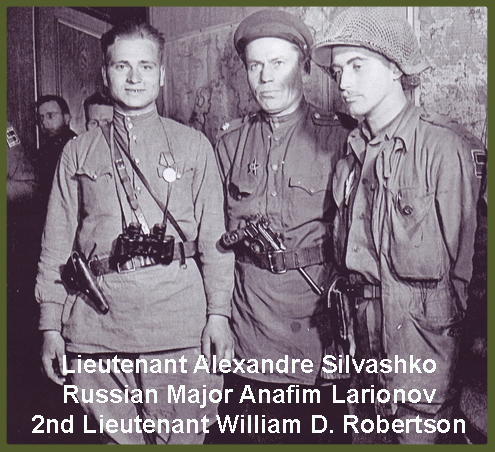
Then, the journal continues, as a report of the events which followed.
"Accompanied by Lieutenant Robertson in the vicinity of where they made first contact. Came from Russian Army at Torgau on the Elbe. The only contact Red 6 (Major Conley) knows of - made late this afternoon. An individual patrol from Red Battalion (the 1st Battalion, 273rd) getting German prisoners to the cage. Coordinates 6441. Is northeast from where Torgau is. Had one jeep out there. Jeep came back. Also a Russian Captain and Lieutenant Patrol from Major Conley's outfit. No one sent patrol. The S-2 was out, going east herding in PW's and were (sic) interrupted in this town by firing. PW's told him Russians were across from the river. Did not go out to meet Russians. First we knew of it was when the man came back with the Russian officer: Something wrong with the O. that cannot tell 5 miles from 25 miles. Trace 6 (General Reinhardt) want to know how it happened. Orders were not to go out over 5 miles. Wants to know why he got way up there".
The division commander was notified and was explosive in his wrath! His first reaction was to court-martial everyone concerned, since it appeared that his orders had been disobeyed. When he reported the incident to the Corps commander he in turn, received the whiplash of General Huebner's displeasure. Everyone had the same orders - not to go beyond five miles east of the Mulde. But the damage was done.
What was the rest of the story? The journal again records fragments of Colonel Adams words to the Chief of Staff:
"Contact was made at 1640 at Torgau. The 173rd Co. (actually, 173rd Infantry Regiment) which belongs to the 58th Guards Division, commanded by Major General Rusakov. He requests a meeting at Torgau at 1000 tomorrow. Tryhard 6 (Colonel Adams) is ready to make it".
But, before he sanctioned any definite move, General Reinhardt wanted to find out the details for himself. The general's orders:
"Want Major sent to Divisional CP so he can personally with G-2 interrogate them before he makes any decisions or informs anyone. How soon can we get him back there. Has radio and telephone with his next higher commander. he is commander of 173rd Co. (actually, a member of the 173rd Regiment)".
The excitement was at fever pitch at regiment and the information was coming out in hasty, garbled, undigested bits.
Back at the Elbe the other two patrols were still negotiating and, at the same time, wondering what had happened to the regiment? Craig and Morey had two guide parties on their way back and were going to remain where they were until the colonel arrived. They knew there was little, if any, resistance between the two rivers over the routes they had traveled. The journal comments:
"Captain Morey and Lieutenant Kotzebue have contacted Russians on the Elbe. Have communications with the forward elm. Moved that element up. Have another contact. Lieutenant Kotzebue and Captain Morey's patrol is at the Elbe, or has been. That is the patrol that had the first contact".
That is the picture as it was known at regimental headquarters on the night of the 25th of April, before Colonel Adams and the Russians departed for Division headquarters. There was definite word that Kotzebue had made first contact, but the exact details as to what was going on at the Elbe were slow and few in coming through. Everyone was excited and, in the attempts to clarify exactly what had transpired, officially and unofficially, attention focused on the four Russians who were present. There were other contacts, yes, but this was tangible evidence. Hence, the other patrols were forgotten in the rush and the erroneous story of the first linkup was spread to the world by over-eager news correspondents and photographers.
There never was any doubt when Craig and Morey messaged: "Have met the general and toasted the Armies".
They went on to say that he desired a meeting at their position east of the Elbe, where there was no bridge but a hand-made ferry, and that they would wait there while guides, who were then on their way back, returned with the official emissaries.
But, again under the pressure of the moment's excitement and high drams, little attention was paid to these messages. The matter at hand was to get the Russians back to division as quickly as possible, since they said they were in combat and were desirous of returning to their outfits right away. In addition to the stranglehold on dissemination of the news in official circles, a new ban on the correspondents went into effect about 2100 that night. As previously agreed, official announcement was to come from the capitals of the United States, Russia and Great Britain.
So, after a short period of eating and toasting at the regimental CP, the entire party took off in a bizarre convoy for division, with the scores of correspondents trailing behind to keep after the story which was coming out in fits and starts! The time was about 2230 and the trip to Naunhof, site of the Division CP, was short.
There, the Russians were introduced to General Reinhardt and the division commander again was given the same data as had been revealed at regiment earlier. Robertson, a short, quiet, tired lad with a stubble of beard, again went through the details of his trip to round up prisoners, a trip on which he rode to fame, despite the fact that his contact was not the first one.
Ostensibly going out, in his role as S-2 of the 1st Battalion, to round up PW's and clear the sector of displaced persons, Robertson rolled up the road from Wurzen towards Torgau. He soon ran out of Germans, but not of miles! He kept going and reached the Elbe City. After much shilly-shallying, he managed to ready a home-made American flag, climbed the river-bank tower of the castle in the town, and, after some palaver and some shooting, succeeded in making himself understood, through an interpreter, to the people on the east bank of the Elbe...the Russians.
The negotiations completed, he dropped quickly through the tower's winding stairs, raced around the wing of the building, scrambled out on the blow castle bridge across the river, and, when about 100 feet from the east bank, pounded a Russian soldier on the knees in greeting and grinned with joy. His contact was made at 1600. He continued to the east bank, parleyed, toasted and drank with the Russian officers and men who met him, and started back to Wurzen with four of their soldiers, three officers and one NCO. After a short delay at the PW camp in Torgau, they proceeded to the 1st Battalion CP. There, the battalion commander was shocked, but recovered quickly. He hastily called regiment and was told to bring them all to the CP. That was the whole story!
General Reinhardt, still upset that his orders seemed to have been observed rather carelessly, ultimately relaxed and felt the glow of pride that his division had been the first one to link with the Russian Army. There was a general round of toasting and good will, but the Russians were urgent in their desire to return. So, after instructing Colonel Adams to attend the meeting in Torgau at 1000 in the morning, and to go back with them that night, the party returned to regimental headquarters at about 0100. Because of the Russian's wish to return immediately, it wasn't long before everyone took off for Torgau. Just before leaving, Colonel Adams aware that his other patrols still were at the Elbe, sent a message to Craig and Kotzebue at 0225 to "hold in abeyance until further orders all arrangements for meeting". But the message still left them in the dark as to what had been going on elsewhere. At the river, most of the members of the two patrols had gone to bed, anyway, hoping that the morning would bring some action their way.
The center of focus slipped then to Torgau, where the colonel's party arrived at about 0530 and was rowed across the Elbe in a couple of out-sized racing shells. On the east bank they were met by the Russian officers and men of the 173rd Infantry Regiment. In a scene marked by its spartan simplicity, sharply delineating the fact that only the day before this had been the front line and, even now, still was in a shady limbo of uncertain security since the Americans had reached across the long stretch of German territory in such scant strength, the visitors were eagerly entertained. Amid the hearty toasts of both sides time slipped by until, shortly after the agreed-upon 1000, Colonel Adams and Colonel Rogol, CO of the 173rd Infantry Regiment met formally along the road which parallels the east bank of the river. It was a quiet friendly meeting between two frontlines commanders who realized that, at least, their act marked the near-end of the war in Europe.
After the swarms of photographers and correspondents had had their fill, the two colonels returned to the feasting and toasting, which continued until Colonel Adams had to leave in order to meet the division commander, whose meeting with the Russian division commander had been arranged for 1600. Shortly after noon, he departed and returned to Trebsen, leaving some of his staff to help with the preparations for General Reinhardt's arrival.
At regiment the general was told of the completion of arrangements for his meeting with the Russian commander and, shortly afterwards, journeyed to Torgau, via Eilenberg, without event. Rowed across the Elbe in the same racing shells as the regimental commander and his party.
General Reinhardt was met on the east bank by a number of Russian staff officers and, after a slight delay through misunderstanding of the exact time, was greeted by Major General Rusakov.
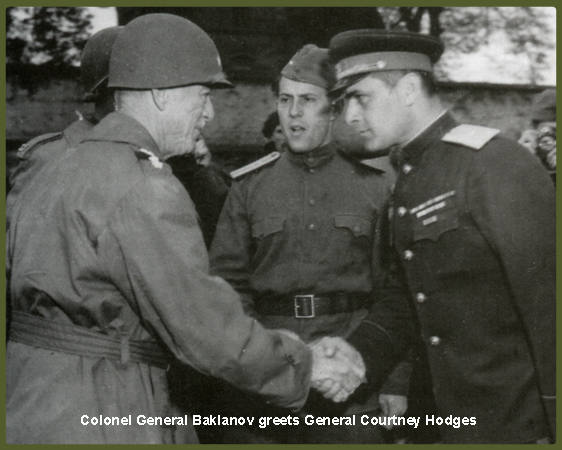
The two generals exchanged greetings and then both, with their parties, adjourned to the same building about a half-mile from the crossing site where Colonel Adams had toasted with Colonel Rogol, and the procedure was repeated. As usual, the photographers and correspondents swarmed all over the place, taking hundreds of pictures. After about two hours of cordiality, the 69th Infantry Division commander departed and returned to his division CP.
Meantime, in a disinterested and tired spirit, the members of the other patrols still were sitting on both sides of the river at Kreinitz, still unaware of what had happened at regiment and at Torgau. They sent a few questioning messages, wondering when someone was going to come out to them. But, mostly, they just waited. Then, about 1700, another patrol reached them, led by Lieutenant-Colonel George C. Knight, the regimental executive officer, and conveyed the news of the other meeting. This was an anti-climax!
That evening back in Trebsen, everyone tried to gather together the bits and pieces of the events which had transpired in the two days. The main surge of excitement was past and the members of the regiment were tired. But the exact sequence of what had happened still was cloudy.
Gradually, these facts were straightened out. But, all the next day, there was an eager anxiety to hear a formal announcement of the linkup.
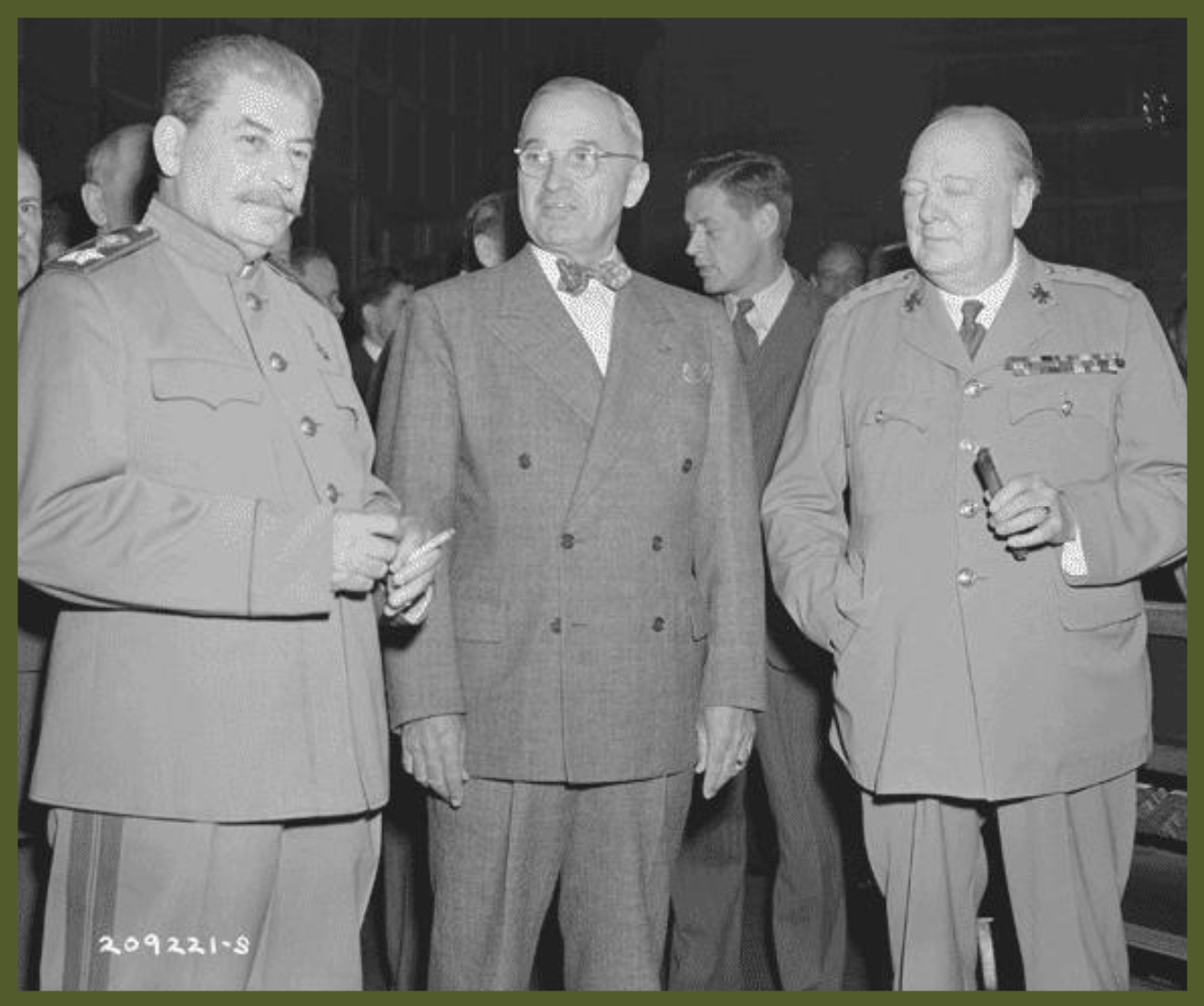
Finally, the word came that the official announcement would be broadcast to the world at 1800 that night, 27 April 1945. At that time, from Washington, London, and Moscow, President Harry S. Truman, Prime Minister Winston S. Churchill, and Soviet Marshal Joseph Stalin, proclaimed simultaneously the news to the world.
The meetings were history. The meetings of the higher commanders still were to come, but the main event was over.
Two weeks later, May 7th, 1945, World War II in Europe was ended with the unconditional surrender of Nazi Germany.
William J. Fox - Captain Infantry
Note: Albert Kotzebue was born on October 10, 1923 in Puerto Rico, retiring from the US Army as a Lieutenant Colonel. He passed away in 1987.
